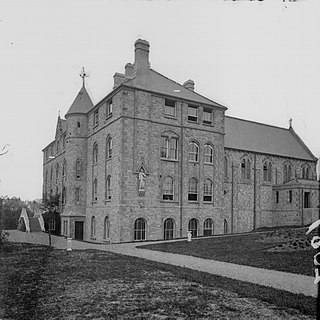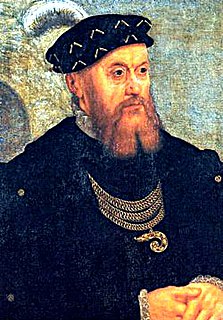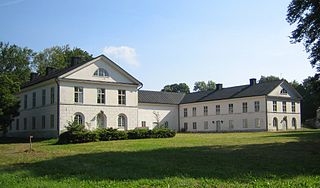History
Kalundborg Friary was founded in 1239 by Ingerd Jacobsdatter (ca.1220-1258), wife of Count Konrad of Revenstein from Halberstadt, Germany, She was a wealthy relative of Esbern Snare (who had founded Kalundborg in 1170) and connected to the powerful Hvide family, and also one of Denmark's greatest landowners. Ingerd was particularly impressed by the teachings of Saint Francis of Assisi which she encountered in Germany and donated land in Kalundborg for the construction of the friary as well as nearby farm properties to fund its works and operation. At the same time she founded other Franciscan houses at Copenhagen, Roskilde and Næstved. [1]
Kalundborg was at the time an important stop on the trade route between the North Sea and the Baltic. The Franciscans benefited from the location of the friary close to the city gate. The first church was consecrated in 1279 and consisted of a single short nave with a choir and an apse. It was built out of brick in the Gothic style.
In 1360 Kalundborg was fortified with a ring wall and towers. The friary was deemed to be a threat to the security of the walls and it was moved a little to the south-west.
The friary was constructed in a skewed rectangle with the church as the south wing. There was a cloister and garden. The exact location of the graveyard is unclear, but from time to time burials have been uncovered by later excavations. The other wings housed the friars and the lay brothers who worked the farms, a rectory and a hospital.
For many years Kalundborg Friary took a liberal view of the vows of chastity and poverty, and ran itself at a profit until 1518, when the chapter voted to return to a stricter interpretation of the rules of Franciscan brotherhood. The properties which had been used to create wealth were sold to the last Roman Catholic king of Denmark, Christian II.
Dissolution
Under Frederik I, successor to Christian after his forced abdication in 1523, Denmark was embroiled in the debate over Luther's reforms of the Roman Catholic church and moved rapidly towards religious reformation. Many Danes were tired of the enforced tithes and the donations sought by monasteries, hospitals, and other religious foundations. Although Frederik officially adopted even-handed treatment of Catholics and Lutherans, he actively promoted Lutheran ideas. He granted local officials permission to forcibly close Franciscan houses all over Denmark, or looked the other way when officials overstepped their authority and closed religious houses without permission. Prince Christian, later Christian III, also encouraged the closure of Franciscan houses on his lands.
In 1532 the governor of Kalundborg Castle forced the Franciscans from the friary at the instigation of Mogens Gjø, an ardent Lutheran who worked tirelessly to force the closure of monasteries on Jutland and Zealand. The last guardian of the friary, Melchior Jensen, offered only token resistance and then became the first Lutheran pastor of Kalundborg. [2]
Denmark became officially Lutheran in October 1536 when all remaining religious houses in the country were closed. The buildings and properties associated with Kalundborg Friary became crown property and were administered by the governor of Kalundborg Castle. The buildings were converted into housing for workers on the royal farms and for storage (Kalundborg Slots Ladegård).
By 1751 most of the friary had already been demolished and a new large farm headquarters building was constructed on the site. Subsequently, the remaining buildings were also pulled down, and there are no visible remains of the 300-year history of the Franciscans in Kalundborg.

A convent is either a community of priests, religious brothers, religious sisters, monks or nuns; or the building used by the community, particularly in the Catholic Church, Lutheran Churches, and the Anglican Communion.

Christian III reigned as King of Denmark from 1534 and King of Norway from 1537 until his death in 1559. During his reign, Christian formed close ties between the church and the crown. He established Lutheranism as the state religion within his realms as part of the Protestant Reformation.

Herrevad Abbey was a Cistercian monastery near Ljungbyhed in Klippan Municipality, Scania, in the south of present-day Sweden, but formerly in Denmark until 1658. It is now a country house known as Herrevad Castle.

Antvorskov was the principal Scandinavian monastery of the Catholic Order of Saint John of Jerusalem, located about one kilometer south of the town of Slagelse on Zealand, Denmark.

Sorø Abbey was the preeminent and wealthiest monastic house in all of Denmark during the Middle Ages. It was located in the town of Sorø in central Zealand.

St. Catherine's Priory, Roskilde, was a priory of Dominican friars located in Roskilde. It was dissolved in the Reformation and a private house built on the site.
Nysted Friary, located in Nysted, on the island of Lolland in southern Denmark, now in Guldborgsund municipality in Region Sjælland, was the last occupied Franciscan friary in Denmark after the Reformation.
The Chronicle of the Expulsion of the Greyfriars is a historical writing on the Reformation in Denmark between 1527 and 1532 when the Franciscans were forced to leave Denmark.
Svendborg Friary was a Franciscan friary in Svendborg, on the island of Funen, in the present Region of Southern Denmark, and was one of the earliest Franciscan foundations in Denmark. Like almost all Danish religious houses it was dissolved during the Protestant Reformation of the 16th century.
St. Peders Kloster, later called Skovkloster, was an important early Benedictine house at Næstved, Denmark, active in 1135-1559.
The Franciscan Friary, Copenhagen was the most important Franciscan friary in Denmark.

Halsted Priory. formerly a small Benedictine house, is a manor house and estate located close to Nakskov on the island of Lolland in southeastern Denmark. The estate was renamed Juellinge when the Barony of Juellinge was restored for Jens Juel-Vind in 1721 but its old name was restored when the barony was dissolved in 1021. Holsted Priory is still owned by the Krag-Juel-Vind-Frijs family. The Neo-Gothic main building is from 1847-49. It is flanked by Halsted Church to the north and the old main building from 1591 to the south. The old main building has been renovated with support from Realdania and is now operated as a local cultural centre. The Baroque-style park covers approximately 6.5 hextares od land. The estate is also home to a golf club.
Holbaek Priory was a small Dominican monastery in Holbæk, Denmark.
Slangerup Abbey was a monastery of first Benedictine nuns, then entrusted to the Cistercian nuns, which was located in Slangerup, Denmark, between 1170 and 1555.
St. Agnes Priory was established by Queen Margaret I for a community of Dominican nuns at Gavnø Island. After the Danish Reformation the priory was transformed into a manor estate known as Gavnø Castle located near Næstved, Denmark.

St. Clare's Priory in Copenhagen, Denmark, was a short-lived community of nuns of the Order of Poor Clares, which lasted from 1497 to 1536. The monastic buildings then came into use as a mint, which after its decommissioning became known as the Old Mint, giving rise to the present day street name Gammel Mønt at the site.

Gjorslev is a cruciform medieval castle located 17 km south-east of Køge, on the Stevns Peninsula, Stevns Municipality, some forty kilometres south of Copenhagen, Denmark. Originally owned by the Bishop of Roskilde, it is considered one of the most well-preserved examples of Gothic secular architecture in Denmark.

Roskilde Station is the principal railway station serving the city of Roskilde, Denmark, situated on the Danish Main Line between Copenhagen and Jutland. The station is also a terminus for the Lille Syd Line which connects Roskilde to Næstved by way of Køge, and the Nordvest Line to Kalundborg.

The Abbey in Ystad, sometimes also simply Greyfriars Abbey is a medieval former friary in Ystad, Sweden. Together with Vadstena Abbey, it is one of the most well-preserved medieval monasteries in Sweden. It today houses the Museum of the cultural history of Ystad.
Ingerd Jakobsdatter, also called Ingerd af Regenstein (1200–1258) was a Danish noble, countess of Regenstein by marriage to count Konrad III of Regenstein. She established the Franciscan and Dominican order in Denmark, and was the founder of the female Franciscan abbey Skt. Clara Kloster af Damiani Orden.










